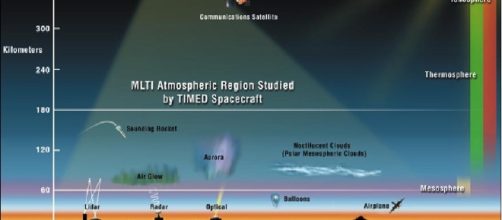Scientists from NASA and many other universities have conducted a study that intends to get a deeper understanding on the region that lies in the earth’s upper atmosphere known as the Ionosphere - a region that marks the boundary between the atmosphere and outer space. This region is permeated by positive and negatively charged particles that create phenomena, such as the auroras but also causing disruption to satellites and communication signals. This region also creates bands of varied colors known as airglow.
High energetic particles into the atmosphere
Scientists released some findings regarding the interaction between the ionosphere and thermosphere and the way in which this interaction create heating, leading to the expansion of the upper atmosphere, which is believed to disrupt satellite orbits. The processes occurring in the ionosphere are due to the activity of the sun, which is constantly sending bursts of solar wind and magnetic fields that interact with particles in the ionosphere.
The ionosphere
This part of the atmosphere is situated at approximately 60-1,000 km ( 37-620 miles) above the surface of the earth. It includes a broad range of the atmosphere, including the thermosphere, the mesosphere and exosphere.
It is ionized by the Sun´s energy and it´s because of this layer of the atmosphere that radio communication is possible. Ionization in the ionosphere is dependent on the sun´s activity and varies with altitude and season. Solar flares and the charged particles associated with it can influence the ionosphere´s activity.
A swelling atmosphere
Based on this study, the energy from the sun-coronal mass ejections (CME), can heat the upper atmosphere, causing it to expand and altering the orbits of satellites. The sun´s energy can also produce a chemical reaction that creates nitric oxide, which can act as a cooling agent, leading to energy loss into space, which scientists call overcooling. Overcooling causes a rapid loss of heat, which stabilizes the previous atmosphere expansion, causing it to recede, perhaps to an even smaller state.
Overcooling
It´s believed that the cooling of the upper atmosphere - the time when the atmosphere loses energy and shrinks is most likely to occur during solar energetic storms (solar storms). Although it has been known that the energy from the sun eventually reaches the ionosphere, scientists had not understood the way in which the transfer of energy occurred; however, up to date studies have revealed that this transfer takes place impulsively.
More powerful than a thunder lightning
It´s thought that during a solar flare, a potential difference can be created in the region between the ionosphere and the magnetosphere, producing am electric current that serves as the pathway for the transfer of electric energy into the ionosphere. It is calculated that the amount of energy transferred into the ionosphere is of hundreds or even thousands of times greater than any thunder lightning could produce during a thunderstorm.

